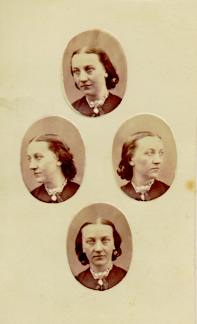 |
The PATENT DIAMOND
CAMEO
The Patent Diamond Cameo photograph was registered by
F.R. Window of London in 1864. Four small oval portraits (1" x 3/4") were placed on a carte de visite in the shape of a diamond, each portrait
being of the same person photographed in a different position. A special camera made by
Dallmeyer was used in which the one glass negative was moved to a new position in the back
of camera after each portrait had been taken, and when the paper print had been pasted on
the card a special press was used to punch the four portraits up into a convex cameo
shape. (continued below) |
It is unlikely the process became very popular with
Adelaide’s photographers, as the failure of just one of the four portraits through
movement, poor expression or incorrect exposure meant that the plate had to be rejected
and another four portraits made on a new plate. To obtain a carte de visite which had a
pleasing overall effect would have involved careful advance planning of the four positions
to be taken, as it was only after the negative was developed that the photographer could
see if an acceptable negative had been produced.
 |
In April 1865 Frazer
Crawford, manager of the Adelaide Photographic Company (q.v.), returned from Melbourne
with ‘all the latest improvements and novelties in photography’ which included a
camera to make Diamond Cameo photographs which, he said, was a new style that was
‘becoming so fashionable.’
Left: Patent Diamond Cameo carte de visite by Adelaide
Photographic Company when Henry Davis was manager. The four cameo portraits have not been
pressed up into relief. |
Townsend Duryea began making Diamond Cameos about May
1865, saying that as he was ‘supplied monthly with all the most recent improvements
by the most eminent photographers of England and America’, he felt it was his duty
‘to the public of South Australia to introduce any improvement or novelty worthy of
note with as little delay as pressure of business will admit of.’ The novelty of the
Diamond Cameo must have worn off by the end of the year as he offered his camera for sale
in December, ‘complete with press and dies.’ His camera may have been bought by
Henry Anson as a Diamond Cameo exists (NC) which was made at his Adelaide Photographic
Institution, 97 Rundle Street. (see Below)
 |
Left: Diamond Cameo carte de visite of "Mrs
Colton" by Henry Anson, Adelaide Photographic Institution, 97 Rundle Street,
Adelaide. His negative number 15093. The four portraits on this carte have been pressed up
into relief. As can be seen, he had some trouble arranging the four poses so that they
appeared balaced when the plate was printed. |
End.


